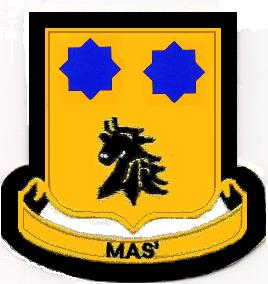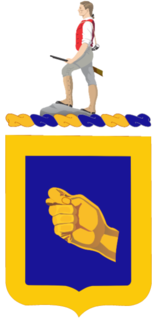Related Research Articles

The 2nd Cavalry Division was a cavalry division of the United States Army.

The 28th Cavalry Regiment (Horse) (Colored) was a short-lived African-American unit of the United States Army. The 28th Cavalry was the last horse-mounted cavalry regiment formed by the U.S. Army. The regiment was formed as part of the 2nd Cavalry Division in 1943 and inactivated in North Africa in 1944 without seeing combat.
The 308th Armored Cavalry Regiment was a Minnesota-based reconnaissance unit of the United States Army Organized Reserve Corps, which briefly existed after World War II. Its 1st Battalion traced its heritage back to a World War II Tank destroyer battalion.

The 304th Cavalry Regiment was a cavalry unit of the United States Army during World War I and the interwar period. It was activated in early 1918 but broken up in the middle of the year to form new artillery units. The unit was recreated as a New York Organized Reserve unit during the interwar period, and was converted into a tank destroyer battalion after the United States entered World War II.

The 302nd Cavalry Regiment was a cavalry unit of the United States Army during World War I, the interwar period, and the Cold War. It was activated in early 1918 but broken up in the middle of the year to form new artillery units. The unit was recreated as a New Jersey Organized Reserve unit during the interwar period, and was converted into a tank destroyer battalion after the United States entered World War II. Reactivated in 1971 and 1973 in the Army Reserve, it was represented by two squadrons in the 100th Division (Training).
The 300th Armored Cavalry Regiment was a Texas-based reconnaissance unit of the United States Army Organized Reserve Corps, which briefly existed after World War II. It was constituted in 1948 and partially organized from existing units before being inactivated in 1950 and disbanded in 1952.

The 309th Cavalry Regiment was a cavalry unit of the United States Army during World War I and the interwar period. It was activated in early 1918 but broken up in the middle of the year to form new artillery units. The unit was recreated as a North Carolina Organized Reserve unit during the interwar period, and later moved to Georgia in the early 1930s. It was converted into a signal aircraft warning regiment after the United States entered World War II.
The 310th Armored Cavalry Regiment was a California-based reconnaissance unit of the United States Army Organized Reserve Corps, which briefly existed after World War II. It was constituted in 1948, partially organized from existing units in 1949, and inactivated in 1950.

The 311th Cavalry Regiment was a cavalry unit of the United States Army during World War I and the interwar period. It was activated in early 1918 but broken up later that year to form new artillery units. The unit was recreated as a Texas Organized Reserve unit during the interwar period. It was disbanded after the United States entered World War II.
The 311th Armored Cavalry Regiment was a Texas and Louisiana-based reconnaissance unit of the United States Army Organized Reserve Corps, which briefly existed after World War II. It was constituted in 1948, partially organized from existing units later that year, and inactivated in 1950.
The 317th Armored Cavalry Regiment was an Illinois-based reconnaissance unit of the United States Army Organized Reserve Corps, which briefly existed after World War II. It was constituted in 1948, partially organized from existing units, and inactivated in 1950.
The 320th Armored Cavalry Regiment was an Ohio-based reconnaissance unit of the United States Army Organized Reserve Corps, which briefly existed after World War II. It was constituted in 1948, partially organized from existing units in 1949, and inactivated in 1950.

The 321st Cavalry Regiment was a cavalry unit of the United States Army during the interwar period. The unit was activated as a Missouri and Arkansas Organized Reserve unit during the interwar period. It was converted into a signal aircraft warning regiment after the United States entered World War II.

The 322nd Cavalry Regiment was a cavalry unit of the United States Army during the interwar period and from the Cold War to the early 1990s. The unit was activated as an Iowa and Minnesota Organized Reserve unit during the interwar period. It was converted into a tank destroyer battalion after the United States entered World War II. Reactivated in 1971 in the Army Reserve, it was eventually represented by two squadrons of the 89th Division (Training) before both were inactivated in the mid-1990s.

The 323rd Cavalry Regiment was a cavalry unit of the United States Army during the interwar period. The unit was activated as a California, Washington, and Oregon Organized Reserve unit during the interwar period, although it was later relocated entirely to California. It was converted into a signal aircraft warning regiment after the United States entered World War II.

The 324th Cavalry Regiment was a cavalry unit of the United States Army during the interwar period. The unit was activated as a Wyoming, Utah, Idaho, and Montana Organized Reserve unit during the interwar period, although it was later relocated entirely to California. It was converted into a tank destroyer battalion after the United States entered World War II.

The 124th Cavalry Regiment is a United States Army cavalry regiment, represented in the Texas Army National Guard by 1st Squadron, 124th Cavalry, part of the 56th Infantry Brigade Combat Team at Waco.

The 297th Infantry Regiment is a parent infantry regiment of the United States Army, represented in the Alaska Army National Guard by the 1st Battalion, tactically part of the 29th Infantry Brigade Combat Team.
The 24th Coast Artillery Regiment was a Coast Artillery regiment in the United States Army. It was the garrison of the Harbor Defenses of Argentia and St. John's, Newfoundland from February 1942 through October 1944, as a battalion after March 1943.
The 90th Infantry Regiment was a Regular Army infantry regiment of the United States Army, which existed during World War I and World War II.
References
Citations
- ↑ "Thomas T. Thornburgh 1918". West Point Association of Graduates. Retrieved 14 August 2017.
- ↑ Stanton 1984, p. 316.
- ↑ Sawicki 1985, p. 193.
Bibliography
- Sawicki, James A. (1985). Cavalry regiments of the US Army. Dumfries, Virginia: Wyvern Publications. ISBN 9780960240463.
- Stanton, Shelby L. (1984). Order of Battle: U.S. Army, World War II . Novato, California: Presidio Press. ISBN 9780891411956.
815th tank destroyer.